SPACE April 2024 (No. 677)
Held in Sharjah, the cultural capital and primary transportation hub of the United Arab Emirates (UAE), the Sharjah Architecture Triennial (SAT) explores design alternatives. Taking aim at the excessive amount of waste produced in contemporary urban life and by present architectural culture, it places new focus on traditional materials and building production methods from the Global South that are less culpable for the climate crisis. It also preserves and reuses Sharjah’s modern architecture, exhibiting in old traditional vegetable markets and slaughterhouses, abandoned mega-malls, abandoned schools, and ghost towns on the outskirts of the city. In the wake of the SAT 2019’s theme ‘Rights of Future Generations’, the SAT 2023, themed ‘The Beauty of Impermanence: An Architecture of Adaptability’, concluded on the 10th of March, 2024 after a four-month journey. SPACE spoke to Tosin Oshinowo, chief curator of SAT 2023, about what makes SAT unique, how it was conceived, and its wider implications for architectural culture.
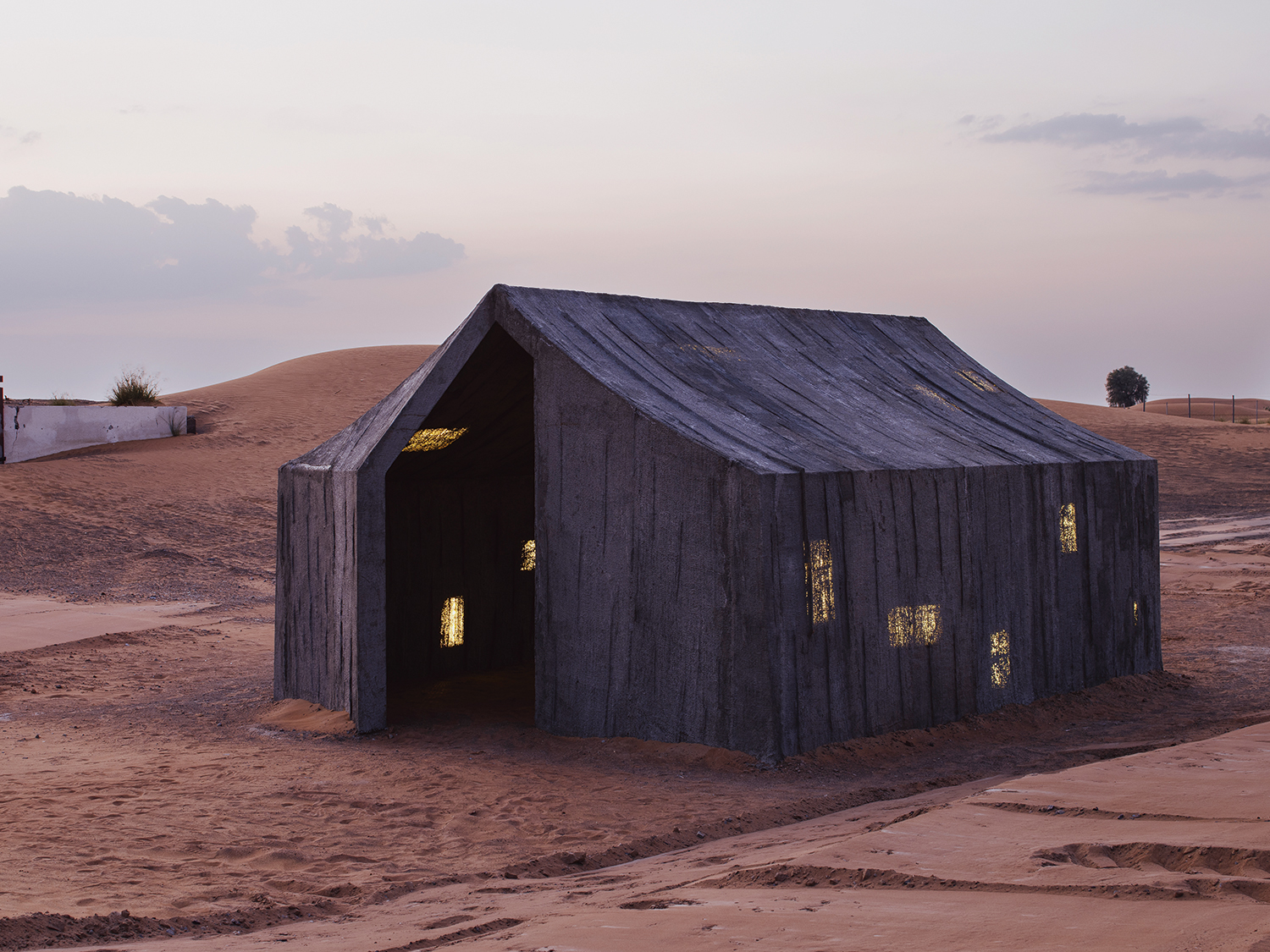
Concrete Tent (2023) by DAAR, located in Al Madam Village
interview Tosin Oshinowo chief curator, Sharjah Architecture Triennial 2023 × Kim Bokyoung
Kim Bokyoung (Kim): SAT pays particular attention to architecture from the Global South. What makes the SAT unique compared to other architecture biennials and triennials?
Tosin Oshinowo (Oshinowo): The Global South relates geographically to regions that were colonised throughout history and, in some cases, are locations that have struggled to progress economically under capitalist systems they were ill-prepared to adopt. SAT is unique in that it focuses on issues relevant to West Asia, South Asia, and the African continent on a globally relevant scale. In the case of the second edition, I attempted to widen this remit to cover the Global South by the inclusion of South America.
We have a mix of 29 emerging and established practitioners: a regional makeup of 32% from sub-Saharan Africa, 12% from the Middle East, and 12% across South America, with the rest equally dispersed across Europe, North America, and South East Asia. Geography and cultural perspectives influenced the selection of participants, but most important to this decision-making process was their deep engagement with the practice that responds to my theme. Their duality of perspective affords them visibility on the subject matter, allowing them to champion innovation as a fundamental requirement for survival.
In addition to architects, there were experts from all fields related to urban life from textile artists to product designers. I run a multidisciplinary practice encompassing architecture, master planning, product design, and interior design. I believe that all disciplines are interlinked, and it is essential to keep in mind the understanding that our solution will be hybridised. SAT sought to find architectural and urban solutions to the climate crisis by illuminating different aspects of architecture through multidisciplinary collaboration.
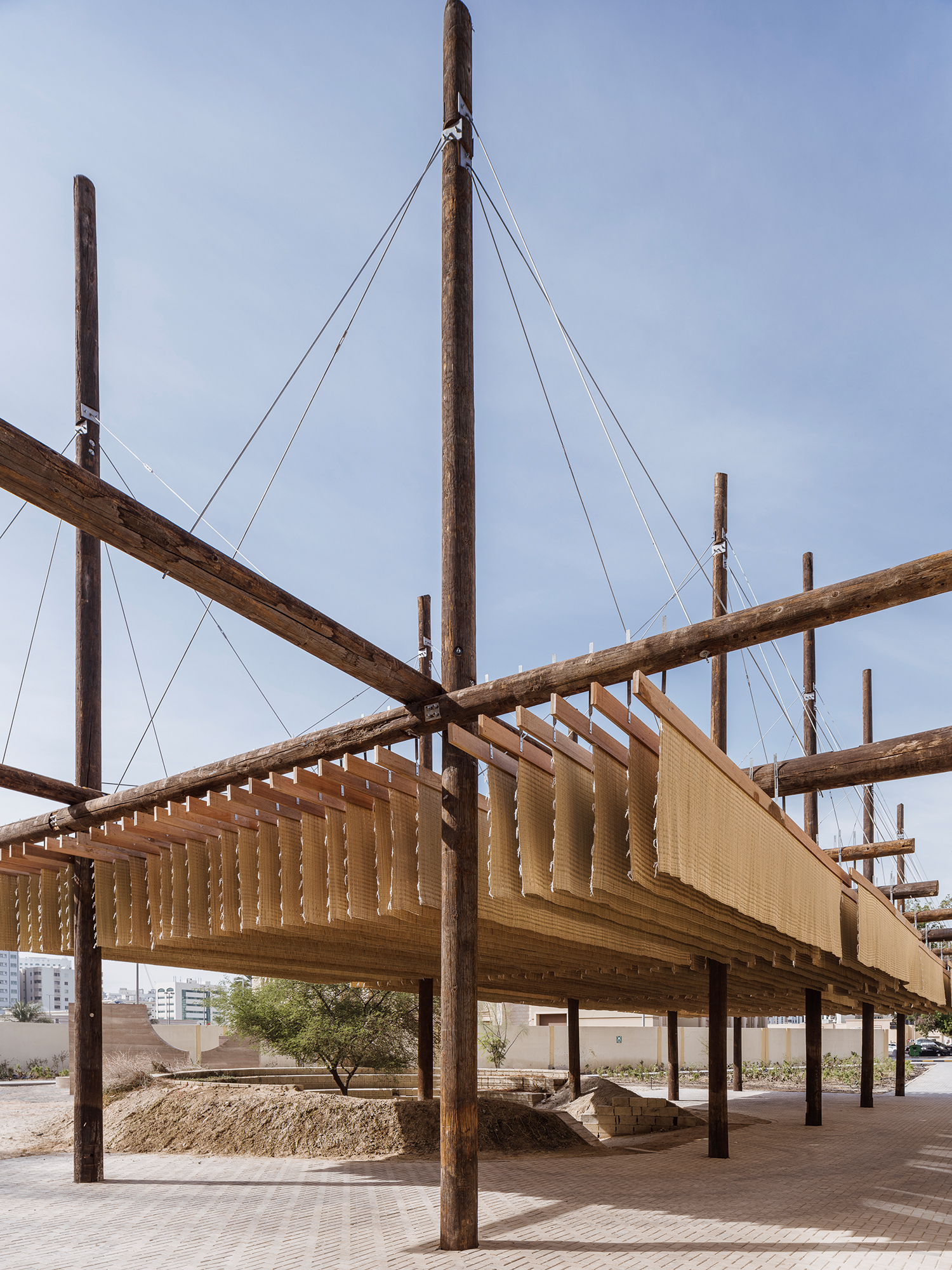
Raw Threshold (2023) by Al Borde, an Ecuadorian architecture firm is made of wooden utility poles and palm tree mats that can be easily reused afterwards. It is used as a pedestrian access to enter Al Qasimiya School and a welcoming platform.
Kim: To flesh out the theme of ‘The Beauty of Impermanence’, you established three sub-categories. It’s interesting to see the concept of ‘impermanence’ given the focus on the climate crisis, with its emphasis on the preservation and reuse of buildings.
Oshinowo: What has been great about curating this exhibition is that it has been about the exchange of knowledge between participants and the curator. Elaborating on the theme of ‘The Beauty of Impermanence’, we established three overlapping strands: ‘Renewed Contextual’, ‘Extraction Politics’, and ‘Intangible Bodies’. ‘Renewed Contextual’ is the concept of recycling that is based on local place and socio-cultural context. These groups of practitioners and artists rethink tradition and posit gentler versions of modernity. In Extraction Politics, participants document the production process and supply chain of the materials used in their work. They show how the global supply chain of resources for urban development and profit overproduces waste, and present contrasting, replenishing alternatives. Intangible Bodies celebrates the ephemeral nature of civilisation’s interaction with the natural environment. Here, participants have been inspired by spirituality, empathy and care, decoloniality, civic status, and futurism, and draw poetic narratives with substantive, actionable responses towards a suggestive and constructive utopian ideal. The strands are a testament to these conversations and emerged as we ideated proposals and practice. As such, the content of the strands was there before they were formally defined as categories, contributing to the strength of the medium and messaging of the exhibition.
The SAT 2023 also organised events in old modern buildings, disused schools and shopping malls in Sharjah to preserve and reuse architecture. Most of our current building solutions involve the complete demolition of old structures with little acknowledgement of their historical value and potential for reuse. Most contemporary structures made from concrete upon demolition contribute in real terms to the already challenging issue of construction waste—so, in solving a problem, we create a new one. In contrast, across the Global South, many practitioners, craftspeople, and communities have embraced long-standing traditions that the canon has systematically ignored. In this light, the second edition was focused on ‘impermanence’ and ‘adaptive reuse’, which involves working with buildings from contemporary or traditional histories by reappropriating them to fit into a new use. These approaches prioritise an understanding of impermanence, inventive responsiveness to limitations, and the psychology of the collective that is essential for our shared future. These systems could pose solutions to addressing planetary scarcity and, in effect, our challenges concerning climate change.

3-Minute Corridor (2023) by Wallmakers, located in Al Qasimiyah School

We Rest at the Bird’s Nest (2023) by Papa Omotayo (principal, MOE+AA) and Eve Nnaji (principal, ADD.apt) was inspired by an alleyway of nurtured plants, a series of cramped mechanic stores hosting small bird cages, foreign to the mechanical landscape found in Sharjah’s Industrial Area 5. Composed of elementary organic waste and scaffolding found in the area, the structure provides a haven for urban birds and a place of respite for humans to experience care and consideration.
Kim: Many of the works in SAT 2023 were created for installation or display elsewhere or as materials for reuse after the exhibition. However, it’s interesting to note that the artistic research practice group Decolonizing Architecture Art Research (DAAR)’s Concrete Tent (2023), a tent that was originally intended to be a temporary structure made of concrete, will remain in place where it is currently installed after the exhibition ends.
Oshinowo: The Concrete Tent by DAAR sits in the Intangible Bodies strand and is a series of works that began as a study of Palestinian refugee camps. It deals with the paradox of ‘permanent temporariness’. The Concrete Tent in Sharjah for SAT is located in Al Madam Village, following the Palestinian refugee camps Dheisheh (2015), Abu Dhabi (2018), and Rabat (2019). Al Madam Village was built in the 1970s, aimed to secure and modernise a nomadic way of life—a mode of existence that was in contrast to forming a new nation-state. Today, these houses in the village are abandoned and taken over by the shifting sands. A reminder that we have no control over so much in the natural world.
The re-creation today of a tent made of concrete is an attempt to preserve the cultural and symbolic importance of this archetype in any story or history of the area, as well as the material manifestation of the temporary status of refugees in the camps which also symbolises their right to return to their homes. Whereas the previous three Concrete Tents were used as gathering spaces for social and cultural events, and communal learning, this time in Sharjah, it will be used for funerals and protests as a sign of mourning and expressing solidarity with Palestine.

Play You Are in Sharjah (2023) by 51-1 Arquitectos, located in Old Al Jubail Vegetable Market
Kim: What other works do you think exemplify each category?
Oshinowo: All the exhibits deeply moved me, but I would like to highlight certain works. Natura Futura Arquitectura (principal, José Fernando Gómez)’s La Balsanera – Productive Floating House (2023) is a building project for a family on the River of Babahoyo, a small city in Ecuador. They exhibited the documentation of the project’s process and results at the SAT 2023. These architects designed for the family’s unique spatial requirements through a participatory design process and analysis of their living spaces. They produced a film shown in the exhibition, which charts the resilience of self-organisational, participatory design, recovers contextual artisanal techniques, and seeks to initiate the implementation of public policy that allows for the regenerative inhabitation of Babahoyo’s riverbanks. This project sets an example which establishes a general triennial and biennial exhibit format.
The 3-Minute Corridor (2023) by India-based architecture group Wallmakers (principal, Vinu Daniel) has been a firm favourite through the exhibition. The point of this piece is to challenge our existing preconceptions of building materials. I invited Wallmakers to participate in the exhibition because I admire their journey as pioneers who create aesthetically striking and intriguing engineering designs using earth in the field as the primary building material. Staying true to their practice, Wallmakers were interested in creating 3-Minute Corridor from materials available in the region. They employed used-tyres for the vertical plane, drawing attention to our global mass consumption. In the horizontal plane, they worked with sand, an abundant material in the region but generally deemed unsuitable for building in its elemental form. The result is an incredible labyrinthine structure that is intriguing and engaging. The composition is an inviting structure that unexpectedly acoustically insulates the interior.
Angolan artist Sandra Poulson’s Dust, as an Accidental Gift (2023) is a recreation of a local market in Luanda, Angola using the mono-materiality of papier-mâché. It looks forensically at the ever-present dust in Luanda, as in many global-south cities, and it reflects the city’s socio-economic, political, cultural, and built landscape. This narrative reminds us of the scares and de-associations of progress due to our association with the clean, hard-cemented surfaces of a colonial past. Luanda Baixa, a formally built and paved cement city, was occupied by white Portuguese settlers during colonial rule. In contrast, Angolan natives lived inland, in mostly informal neighbourhoods paved by the dust. These urban environments influenced the semiotic borders that prevented class mobility for native Angolan inhabitants.

Super Limbo (2023) by Limbo Accra is a public architecture and art pavilion installed in Sharjah Mall, one of the largest unfinished building projects in the UAE. It aims to subvert the stigma of unfinished space and bring a new narrative to the space.
Kim: During the SAT 2023, I heard that three local developers were interested in a new technology presented by a participant.
Oshinowo: The Triennial is also a platform for experimentation. Hive Earth (co-principals, Christian Kwame Deheer, Joelle Eyeson), a practice from Ghana, has been developed and constructed using the technique of rámmed éarth. For the Triennial, they collaborated with the SAT to construct a site-specific installation ETA’DAN (2023) using rámmed éarth. Earlier in the triennial, when they had visited Sharjah, they hosted a workshop with some children. Upon removing them from rámmed éarth miniature house moulds they made, we noticed significant failures. The application used in Ghana could only work seamlessly with research and development in the local ground conditions. To this effect, they realised that it is not a technology that has been used widely in the region because the material of abundance is sand, which is not ideal for rammed earth, but the use of aggregate rock makes it more feasible. In addition, regions of UAE have several sedimentary rocks with various colours that provide the aesthetic layering we associate with rámmed éarth. We have construction companies showing interest because it has significant potential as a commercial means of building, and this is a sustainable solution compared to concrete.
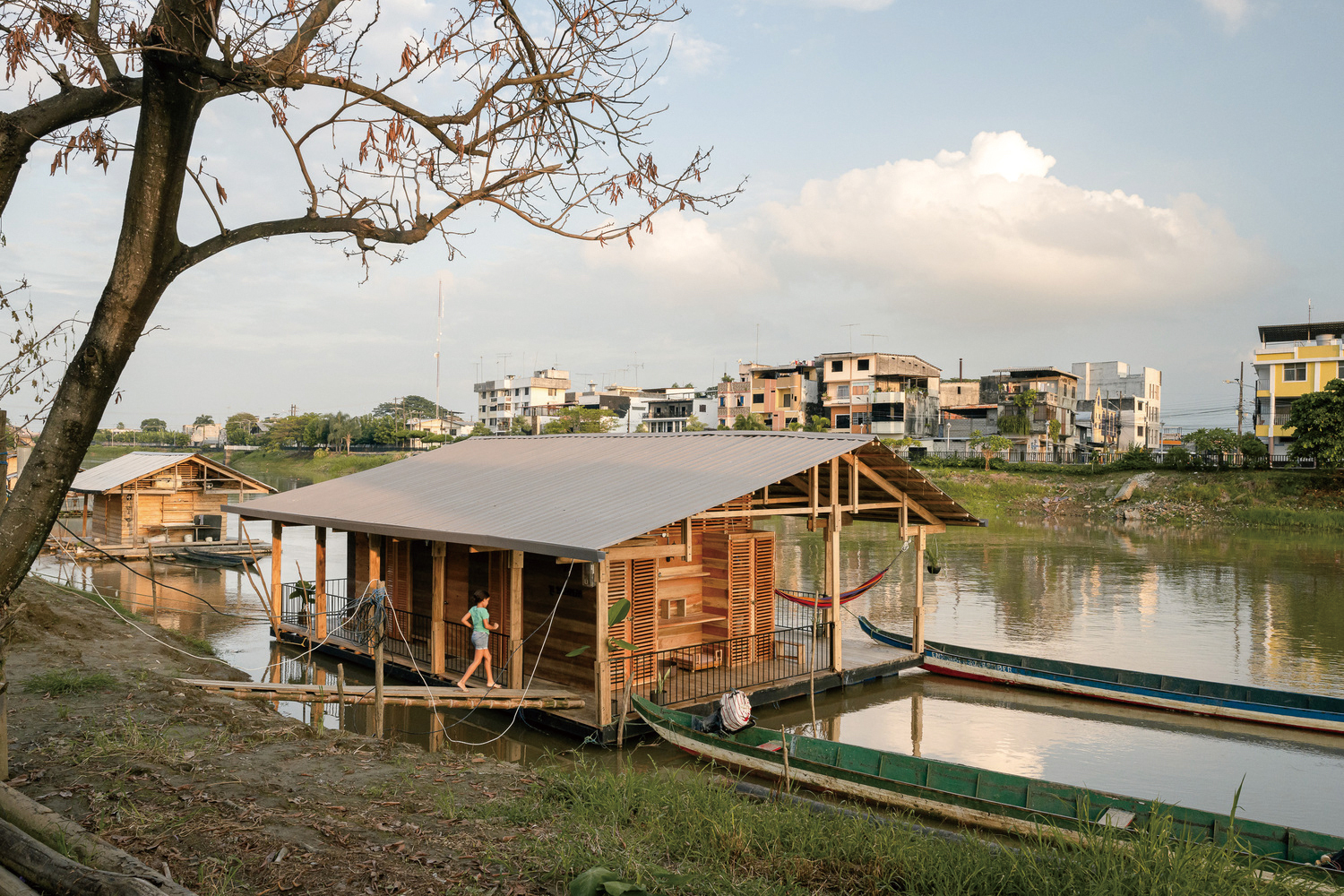
La Balsanera – Productive Floating House (2023) by Natura Futura Arquitectura, built in Babahoyo, Ecuador ©Francesco Russo / Image courtesy of Natura Futura Arquitectura
Kim: It’s encouraging to see how SAT has practically led to the commercialisation of sustainable building technologies. With the proliferation of architecture biennials and triennials, there is criticism that they do not adequately showcase architectural innovation. What role do you think these events should play in the architecture world?
Oshinowo: Architecture as a profession is very long-winded, and the innovations and solutions that do occur in the profession are slow to be implemented due to the reality of project delivery from design inception to finished product. Biennials and triennials play a critical role in ensuring we consistently and within shorter cycles revisit our value systems as a profession, challenging what we intend to achieve in terms of societal and the environmental impacts across the discipline.
The SAT Foundation does not want the exhibition to be a temporary event but to continue to intervene in local life and bring about change. In between every triennial cycle, the foundation engages diverse audiences and stakeholders in a collective conversation on architecture at the neighbourhood, city, and regional levels. Institutional research and programming support ongoing critical reflection through exhibitions, publications, and public programmes in tandem with its international editions. For this cycle, we also encouraged local engagement through guided tours, workshops, activities, and film screenings throughout the exhibition.
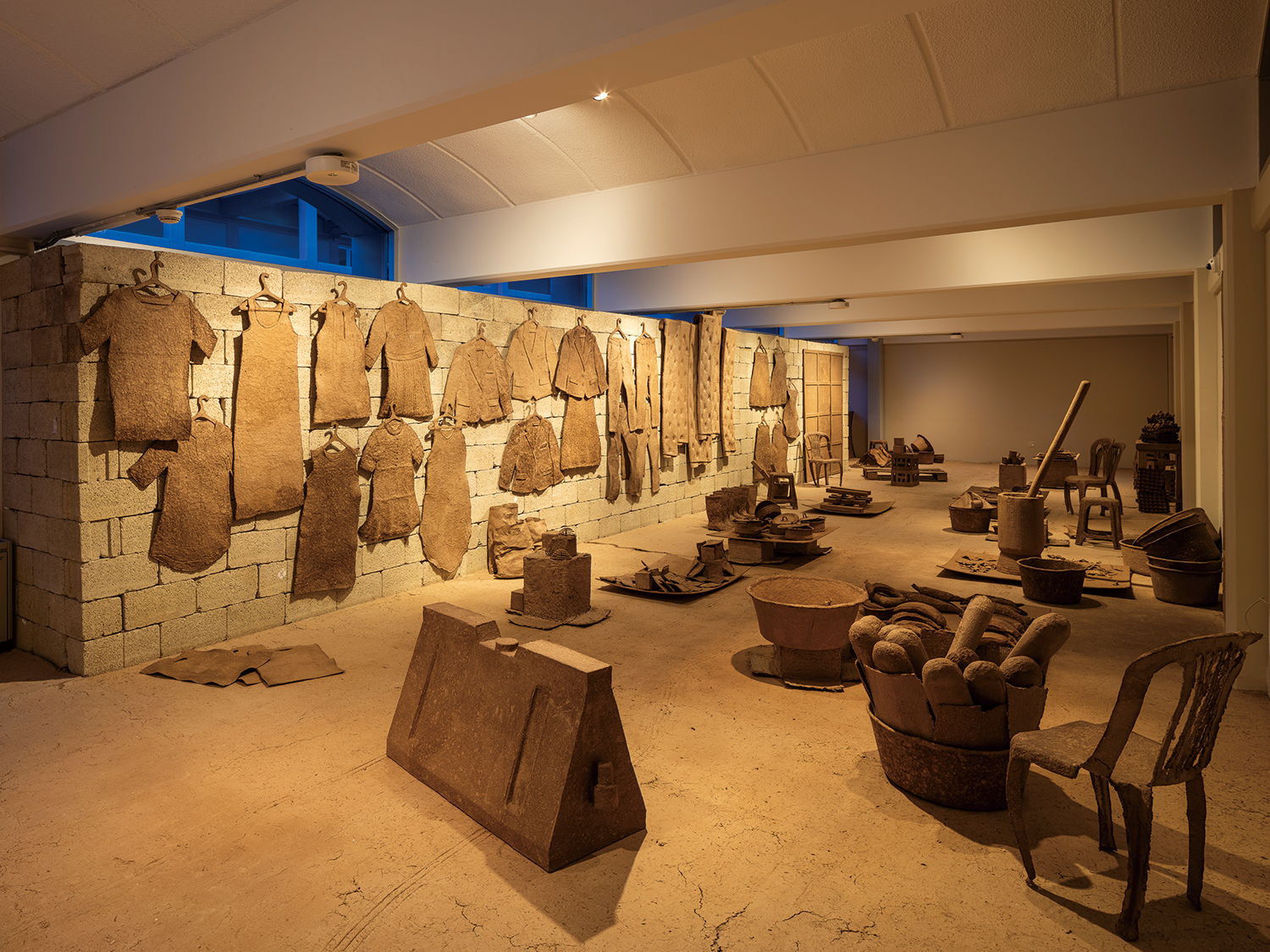
Dust, as an Accidental Gift by Sandra Poulson, displayed in Al Qasimiyah School
Kim: You have defined your architectural style as Afro-Minimalism. It is a concept that connects your modernist aesthetic with your identity as both Nigerian and Yoruba. It localises the design by revealing the materiality of local natural materials. How has this style of work informed SAT 2023, and conversely, how has this exhibition influenced your future work?
Oshinowo: My experiences living and practising architecture in Lagos, Nigeria, informed the theme for this exhibition, as well as my earlier experiences curating. I co-curated the Lagos Biennial in 2019. Titled, ‘How to Build a Lagoon with Just a Bottle of Wine?’ The exhibition took the city of Lagos as its epicentre and point of departure for a broader investigation of how contemporary artists, designers, and other creatives are responding to the challenges of today. This SAT, ‘The Beauty of Impermanence’, is informed by similar experiences but is more focused on the experiences of living in and practising architecture formed under a climate of scarcity.
My practice work aligns with the Renewed Contextual strand of the exhibition, which means I not only look at the material context but the cultural context of the architect and how that influenced identity. The curation of this exhibition has had a profound effect on my thought process, and this will also influence my practice.
I hope the work on show in Sharjah will foster a lasting legacy of exchange that contributes towards a very timely and urgent conversation concerning the climate crisis, as well as reminding us all of the importance and impact of our capitalist work on the climate, the values we all as individuals place on these things and hopefully an opportunity to reflect on what is truly important. I also hope the work on display inspired practitioners to think and act differently, reframe their approach towards practice and to acknowledge the essential values found in artisanal practices and how these can contribute to a modern conversation concerning our discipline.
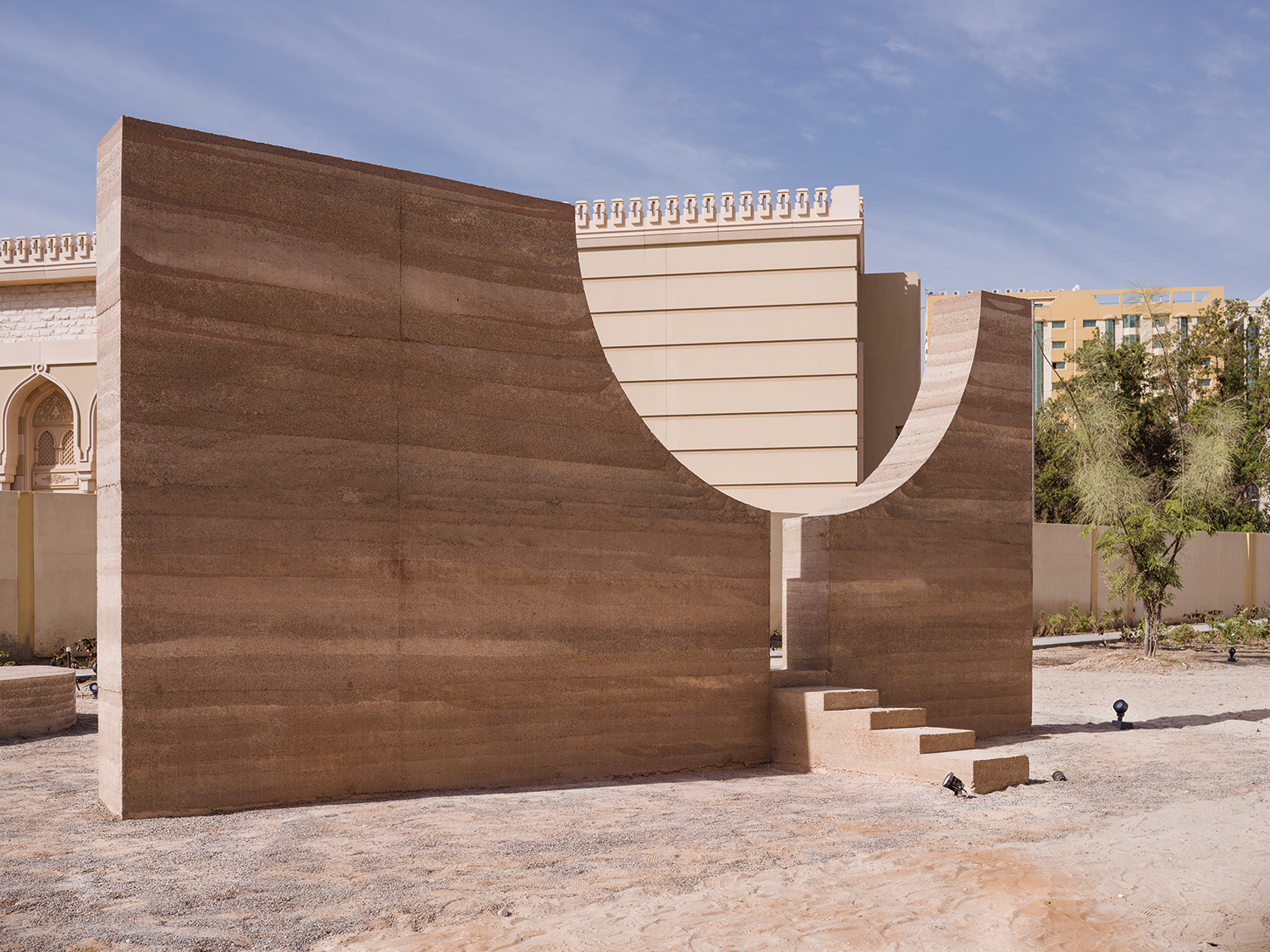
ETA’DAN (2023) by Hive Earth, located in Al Qasimiyah School






